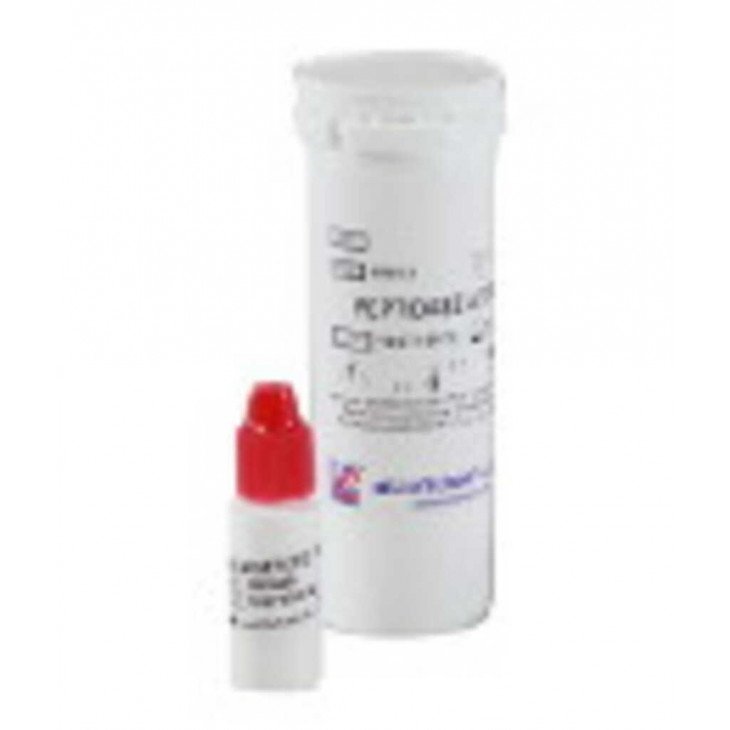Specifications:
| Application | Microbiology |
| Storage Temperature | 2-8°C |
| Product Type | Biochemical Reagent |
| Product Brand | Liofilchem |
| Product Grade | Microbiology grade |
The Urea Rapid Test by Liofilchem is a diagnostic tool designed for rapid detection of urease activity in bacterial isolates. The test is particularly useful for distinguishing Proteus, Klebsiella, and certain urease-positive yeasts from urease-negative organisms like Salmonella spp.. This test serves as an aid in diagnostic workflows, requiring further confirmatory tests to complete the identification process. Its easy-to-use design and rapid results make it ideal for microbiological laboratories.
Key Features
- Rapid Urease Detection:
- Designed to quickly detect the production of urease enzyme by certain bacteria and yeasts.
- Utilizes a color change in the phenol red indicator to confirm the presence of urease activity.
- Broad Applicability:
- Used for differentiating Salmonella spp. (urease-negative) from urease-positive organisms like Proteus and Klebsiella.
- Effective for testing clinical and non-clinical bacterial isolates.
- Convenient Kit Format:
- Contains 30 individual test tubes pre-filled with desiccated reagents, allowing multiple tests per kit.
- Rapid Results:
- Positive urease activity is indicated by a color change to red-fuchsia, often visible within 1–4 hours of incubation.
- Complete results are available within 24 hours.
Composition
Each test tube contains:
- Proteic Substrata: Provides nutrients for bacterial growth.
- Urea: The target substrate for urease activity.
- Phenol Red: pH indicator that changes color in response to urease-induced alkalinization.
How It Works
- Enzymatic Reaction:
- Urease hydrolyzes urea into ammonia, water, and carbon dioxide.
- The release of ammonia increases the pH of the medium, causing the phenol red indicator to change color from yellow to red-fuchsia.
Test Procedure
- Preparation:
- Allow the required number of test tubes to reach room temperature.
- Add 0.3 mL of sterile physiological solution (0.85% saline) to each tube.
- Inoculation:
- Use a fresh overnight culture to prepare a microbial suspension equivalent to 0.5 McFarland turbidity standard (1–2 x 10⁸ CFU/mL for E. coli).
- Inoculate the suspension into the test tube.
- Incubation:
- Incubate the tubes at 35 ± 2°C.
- Observe for color changes at 1 hour, 4 hours, and up to 24 hours.
- Interpretation:
- Positive Result: Medium turns red-fuchsia (urease-positive organisms like Proteus mirabilis).
- Negative Result: No color change; the medium remains yellow (urease-negative organisms like E. coli).
Applications
- Identification of urease-positive bacteria in clinical microbiology, such as Proteus, Klebsiella, and certain yeasts.
- Differentiation of Salmonella spp. (urease-negative) from urease-positive organisms.
- Use in environmental and food microbiology for bacterial differentiation.
Quality Control
- Appearance:
- Dry powder: Yellowish.
- Reconstituted solution: Yellow.
- Control Strains:
- Escherichia coli (ATCC® 25922): Negative reaction (no color change).
- Proteus mirabilis (ATCC® 29906): Positive reaction (color change to red-fuchsia).
- Salmonella Typhimurium (ATCC® 14028): Negative reaction (no color change).
Storage and Stability
- Temperature: Store at 2–8°C in its original packaging.
- Shelf Life: 1 year. Do not use beyond the expiry date or if signs of deterioration are observed.
Precautions
- For Professional Use Only:
- Designed for laboratory settings and must be handled by trained personnel.
- Safety:
- Follow aseptic techniques to prevent contamination.
- Dispose of used materials as per local and national regulations.
- False Positives:
- Prolonged incubation may result in false positives due to protein hydrolysis in the medium.
- Cross-contamination:
- Avoid by using disposable inoculation tools and ensuring sterility during testing.
Limitations
- False-negative results may occur with strains that grow poorly on the medium.
- Pigmented organisms may yield ambiguous results.
- Additional confirmatory tests are required for final identification.
Product Packaging
- Kit contains 30 test tubes, each pre-filled with reagents.
References
- Christensen, W.B. (1946). "Urea hydrolysis in the differentiation of bacteria." Journal of Bacteriology.
- Public Health England (2019). "Urease test." UK Standards for Microbiology Investigations.
Order Information
- Catalog Number: 88011
- Packaging: 30 tests per kit
For more details, refer to the technical documentation and quality standards for microbiological testing.




 0
0
